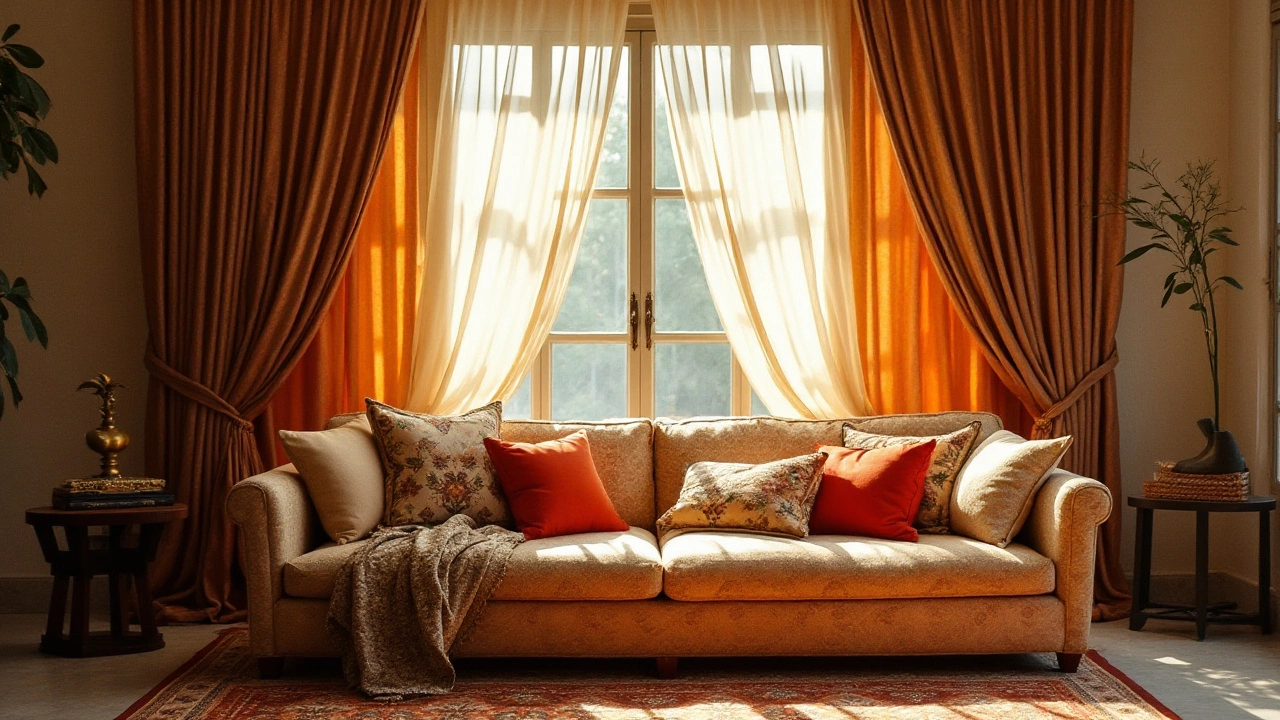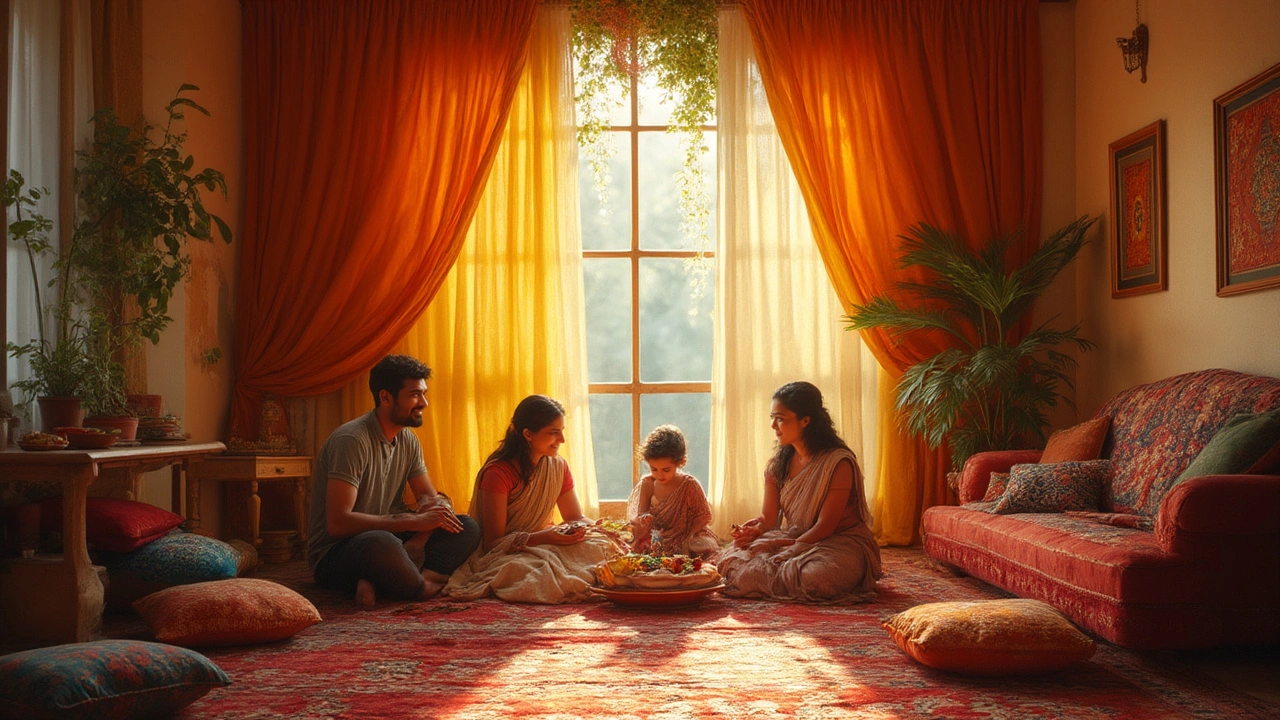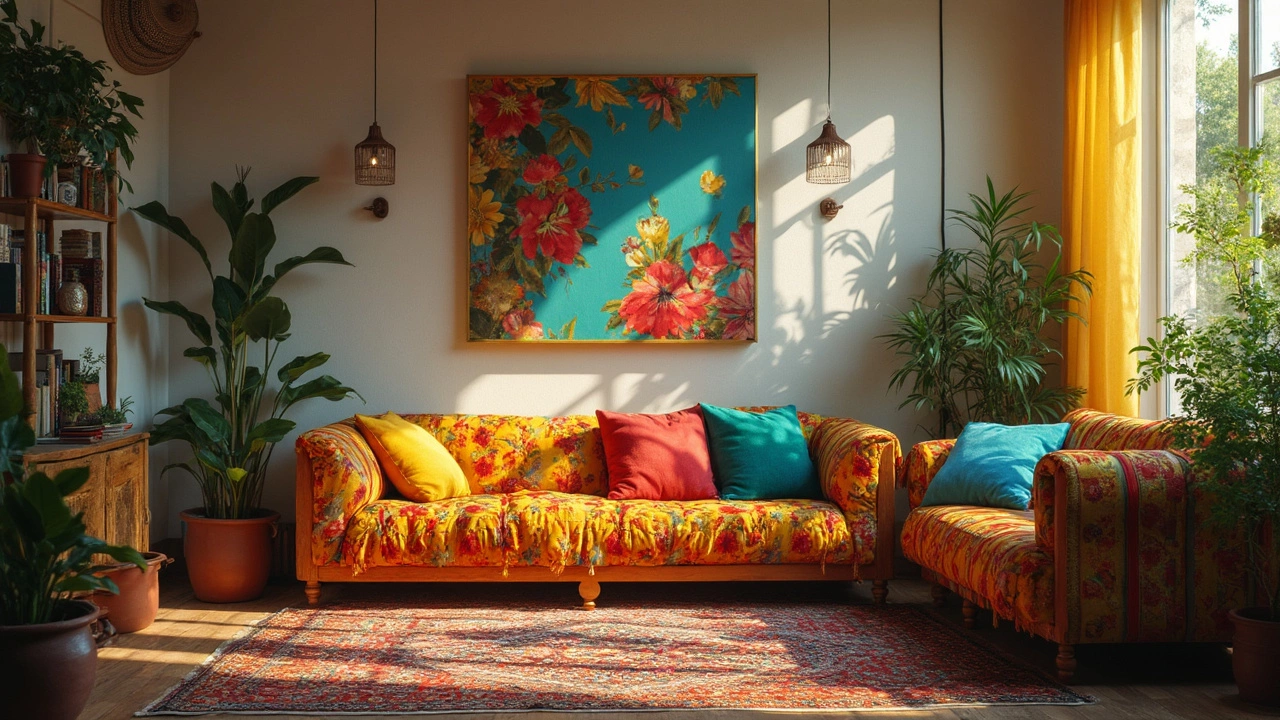Choosing the right curtains is about more than just blocking out sunlight or prying eyes. It's an essential part of crafting the mood and visual coherence of your room. Often, homeowners and design enthusiasts ponder whether curtains should align with the floor's hue or the sofa's shade. This decorating dilemma isn't just a matter of color; it involves a balance of textures, proportions, and room utility.
Navigating this choice successfully can tie together a room's look more than you might realize. By considering the psychology of color, the pull of patterns, and the practical needs of your space, you can choose curtains that feel just right. Whether your goal is to create a calming sanctuary or a lively entertaining space, the right decision begins with understanding your design vision and the pieces already in place.
- The Role of Curtains in Interior Design
- Color Psychology and Room Atmosphere
- Coordinating Curtains with the Sofa
- Harmonizing Curtains with the Floor
- Balancing Patterns and Textures
- Practical Tips for Choosing the Right Curtains
The Role of Curtains in Interior Design
Curtains, those often overlooked pieces of fabric, hold the power to both transform a space and enhance its functionality. In modern interior design, they are not merely an afterthought but a critical element of style and comfort. Curtains serve multiple roles in a living space: they can act as acoustic buffers, temperature regulators, and bold visual statements. The decision to synchronize them with the sofa or the floor impacts not just the look but the feel of your home.
In an era where open-plan living and minimalism dominate design trends, the importance of curtains as decorative anchors has surged. They break up spaces visually, providing a sense of containment and privacy without sacrificing the aesthetic openness of the room. For instance, in homes with large glass walls or sliding doors—common in Wellington to take advantage of the stunning views—curtains frame windows in a way that enhances rather than obstructs the view. This subtle but effective touch shifts the perception of space, adding depth and character to otherwise unadorned expanses.
“Curtains can pull together a room's decor much like a great painting can, bringing seemingly disparate design elements into a cohesive whole.” — Architectural Digest
Beyond aesthetics, curtains play a vital role in sustainability and energy efficiency. With climate consciousness at the forefront of many homeowners' minds, selecting the right fabric and lining can help reduce heating and cooling costs. Thermal curtains, for instance, are engineered to block the transfer of heat, making them a wise choice for homes looking to lower their energy footprint. This functional benefit combined with strategic color and pattern choices can echo the hues of the floor or sofa, creating harmony without compromising practicality.
Choosing the Right Style
Deciding on curtain styles involves a symbiotic understanding of your existing home decor. Sometimes, opting for a bold, contrasting color can energize the space, while other situations call for a subtle blend that complements wooden floors or patterned rugs. Customization is key here, allowing for a personalized interplay of light, pattern, and privacy. Patterned curtains can introduce a playful edge or a sophisticated elegance depending on the theme. The depth this layer of decor adds often encourages more inventive uses of color schemes.Consider also the mounting techniques. Floor-to-ceiling draperies can elongate rooms, making ceilings appear higher, a trick fancied by many interior designers. Choices like the rod pocket, eyelet, or tab top each lend a different nuance, influencing how fabric hangs and interacts with natural light. These choices reflect personal preferences while subtly adjusting the spatial dynamics of a room.
Finally, we must appreciate curtains as multi-tasking accessories that bridge the practical and aesthetic needs of a room. In deciding whether they should align with the tones of your sofa or the fibers of your floor, it's important to view them as part of a larger design narrative that speaks to every corner of your home.
Color Psychology and Room Atmosphere
When it comes to designing a space, the impact of color choices should never be underestimated. Colors do more than highlight decor; they subtly influence our emotions and perceptions. In the world of interior design, understanding the psychology behind colors can help you craft a room's mood. Take blue, for example: often associated with calmness and serenity, it's ideal for rooms meant for relaxation. On the other hand, colors like red and orange are energetic and stimulating, making them perfect for social spaces.
Choosing curtains, whether to match your sofa or floor, depends significantly on the atmosphere you wish to create. Green is another popular choice, known for its refreshing and natural feel. It can bring a sense of tranquility to a room, making it functional both for lounges and sleeping areas. Consider this when your room contains both these elements. Color is not just about the hue but also the intensity. Lighter shades can make a space feel open and airy, while darker tones exude coziness and sophistication.
"Color is a power which directly influences the soul." - Wassily Kandinsky
In integrating the broader aspects of color psychology, one must account for saturation and contrast. High saturation colors make bold statements and command attention, perhaps to highlight a beautiful floor pattern or a striking piece of furniture. Conversely, low saturation colors act as gentle backdrops, allowing other elements to shine. Complementing the base colors with curtains that either match or contrast can cleverly enhance the room’s dynamic without overwhelming.
Color Combinations and Emotional Impact
Crafting a memorable room design involves playing with color combinations that align with your emotional objectives. Pairing cool tones like blue with neutral greys can produce an elegant and sophisticated atmosphere, often chosen for contemporary or minimalistic styles. Alternatively, warm tones like terracotta or ochre introduce warmth and are instant conversation starters. Knowing this, you can turn to historic data and surveys which show that working spaces painted in softer, more neutral colors result in increased productivity compared to those with bold hues.Every personal space can be tailored to individual lifestyles and functions using the vibrant canvas of colors. By playing with different intensities and combinations, and choosing whether to align curtains with the floor or the sofa, your curtain choice becomes a cog in the intricate wheel of interior design strategy. It's not just about aesthetics; it's about fostering spaces for lived experiences, joy, and comfort.
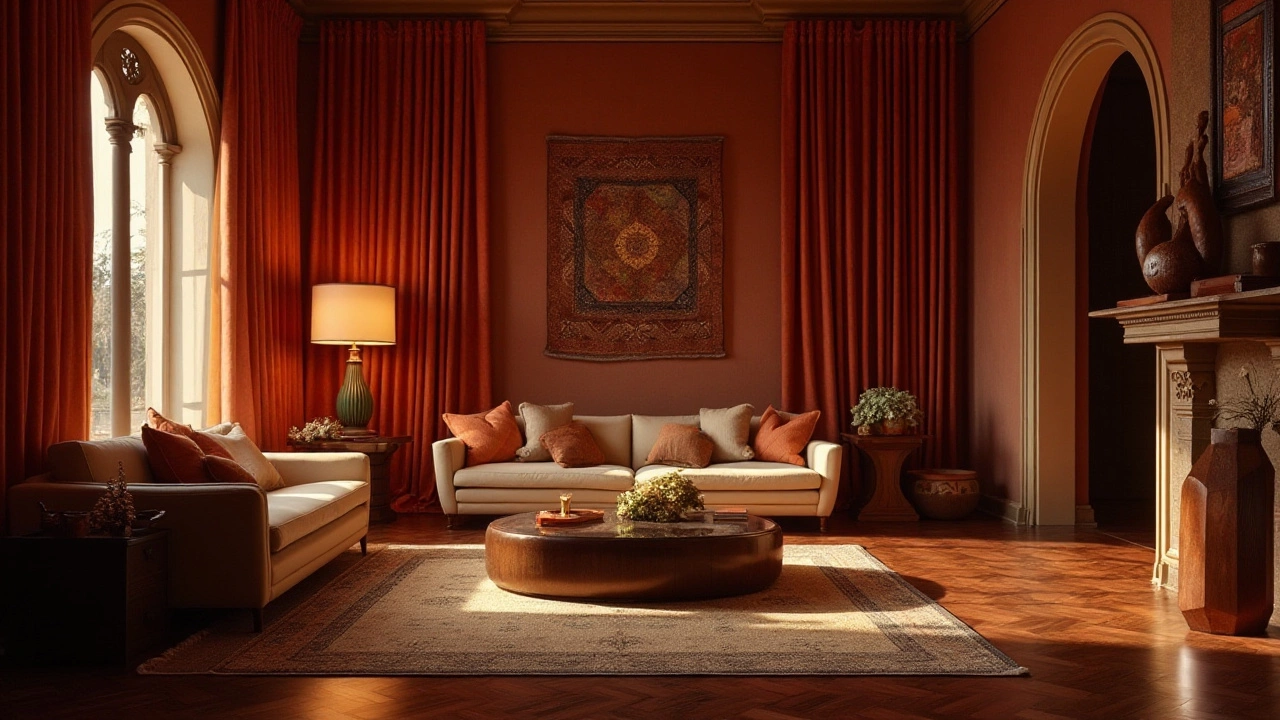
Coordinating Curtains with the Sofa
When deciding on the perfect curtains for your living room, matching or complementing them with your sofa can be a masterstroke in the art of interior design. The sofa often dominates the room due to its size and central position, making it a natural anchor point for uniting other elements like curtains. Choosing curtains that echo the sofa's color, texture, or style creates a cohesive look that can make your space feel well-curated and harmonious. For instance, a beige sofa can be beautifully emphasized with champagne or taupe curtains, lending an air of understated elegance.
The key to pulling off this look is to avoid exact matches in hue unless you're going for a monochromatic scheme. Instead, aim for complimenting colors that reflect or play with your sofa's tone. An effective approach involves using a color wheel to find complementary shades that will both contrast and highlight your sofa. This method can add depth and interest to your room without overwhelming the senses.
"Design is not just what it looks like and feels like. Design is how it works." - Steve Jobs
Textures are equally important in this equation. A leather sofa pairs wonderfully with curtains that add softness to the room, such as those made from silk or velvet. On the flip side, a plush fabric sofa might benefit from the sleeker look of linen or sheer curtains that contribute to a lighter atmosphere. Patterned sofas offer an additional challenge. Here, selecting a solid hue for your curtains, ideally one that is present within the sofa's pattern, can create synergy without too much activity.
If you're feeling adventurous, don't shy away from using patterns on your curtains as well. Just ensure that the sofa and curtain patterns don't compete but rather complement each other. A patterned sofa with geometric prints could pair with subtly striped or lightly floral curtains. Consider incorporating common colors from both elements to maintain a unified theme. The harmonious blend of home decor elements makes your space feel thoughtfully designed.
Navigating the world of interior design can be daunting, but starting with something as fundamental as the sofa-couch relationship can smooth the entire process. Understanding the points where these two elements meet – color, texture, pattern – provides a foundation from which to experiment and ultimately express your distinct style.
Harmonizing Curtains with the Floor
When it comes to aligning your curtains with the floor, a seamless visual flow can transform a room from merely styled to perfectly polished. Selecting curtains that echo the color or texture of your flooring can create a unified aesthetic that feels intentional and grounded. The key is to find a harmonious balance that enhances your furniture's presence while bringing warmth and cohesiveness to the space. When the colors and patterns sync, it can help the space feel larger and more connected, offering a visual continuity that can be pleasing to the eye.
Most individuals gravitate towards this approach because it simplifies the palette of the room, reducing clashing elements. For instance, wood or laminate floors pair well with rich, textured curtains that can pick up on tones like walnut or oak. This doesn't mean your curtains should exactly match the floor, but they can certainly echo the undertone. Consider a room with dark mahogany floors; pairing these with curtains that feature auburn or burgundy hues can create a sophisticated look. Light and neutral-toned floors, on the other hand, often benefit from soft pastel curtains or those in linen-white shades, keeping the room light and airy.
It's important to remember that different patterns and textures can add depth. If your flooring is particularly uniform, adding curtains with a subtle pattern allows for an extra layer of interest without overcomplicating the design. Conversely, if your floors are patterned, such as a dynamic tile or intricate woodwork, choosing solid curtains can provide balance. Patios or spaces with tiled floors may find resonance and warmth through earth-toned curtains that align with the tile’s biggest shades.
"Design is not just what it looks like and feels like. Design is how it works." - Steve Jobs
Let’s not forget functional considerations like the room's amount of light. In rooms where natural light is abundant and the floors are a dark wood, lighter or sheer curtains can create striking contrast, accentuating light interplay. Providing this contrast keeps the room from feeling too heavy or somber. In such designs, it's fundamental to draw inspiration from the flooring material and incorporate complementary hues. Textures can speak to the floor's character—using a matte curtain for glossy floors or vice versa establishes a compelling design dialogue.
When harmonizing your curtains with your floors, it also pays off to take note of how they’ll work with other room elements. Consideration should be given to how this decision will influence the rest of your design choices. Will the furniture look and feel balanced? Is there too much color concentration at specific points in the room? Answering these questions will help guide you to not only creating a pleasing arrangement of curtains and flooring but an entire room's aesthetic that’s well put together.
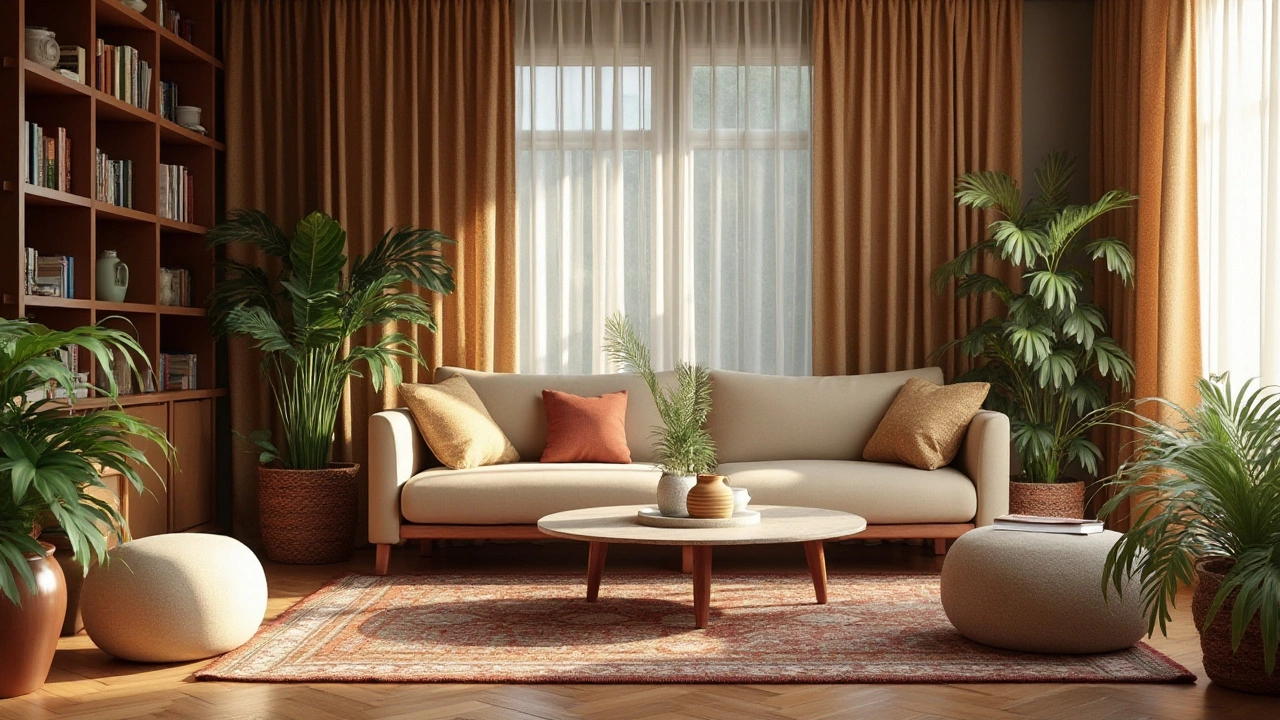
Balancing Patterns and Textures
When it comes to selecting the perfect curtains for a room, balancing patterns and textures can make all the difference. The art of combining these elements requires a keen eye, but when done right, it can elevate the entire ambiance. Many designers believe that the way textures and patterns interact is crucial in defining a room’s personality. For instance, if your room features a heavily textured floor, like a rich shag carpet, you might consider smoother, more subtle textures for your curtains to create a visual balance. Don’t shy away from patterns—you can mix geometric prints on the floor with floral motifs on your curtains, as long as they share a color palette. The essential skill here is creating harmony rather than letting the eye clash with too many competing elements. By maintaining a visual language throughout the room, everything feels cohesive and intentional.
Patterns and textures are not just about aesthetics; they're about storytelling. A room with a velvet sofa might speak of opulence and traditional charm, which you could enhance with regal damask-patterned curtains. But watch out for overdoing it—there's a thin line between opulence and overwhelm. When deciding which textures to highlight, think about the practical aspects too. Heavier curtain fabrics will add warmth in cooler months, creating a cocoon-like effect that’s both functional and stylish. Cotton or linen curtains, though, lend an airy feel and are perfect for emptying rooms that prioritize simplicity and light. An interior design study revealed that mixing patterns in home décor increases perceived warmth and comfort by nearly 50%, which suggests that this method has an instinctive benefit we can all appreciate.
Even though the idea of mixing patterns and textures might seem daunting, remember that it’s an opportunity to express your personal style. Opt for larger patterns on curtain panels if the rest of the room's architecture is simple, as this can add a dynamic focal point. Conversely, in spaces filled with intricate structural features or ornate furniture, subtle textures in your curtain choice might be more appropriate. As famed decorator Dorothy Draper once said,
“I always put in one controversial item. It makes people talk.”So do not be afraid to take bold steps—it’s your space, and it should mirror your unique aesthetic vision. Many experts recommend choosing a dominant pattern and then supporting it with secondary textures to avoid overwhelm—a strategy that often results in a balanced and inviting space.
Lastly, let’s not forget about the role of light in enhancing textures. The way light plays with curtain fabric can dramatically alter the perception of both color and pattern throughout the day. Natural sunlight filtering through sheer, printed curtains can project delicate patterns into your room, adding depth without clutter. In evening lighting, however, richer textures might be called upon to bring warmth and intrigue to your sanctuary. Consider practicalities like maintenance too; intricate patterns may become a cleaning nightmare if they hold dust or odors, especially in high-traffic areas. So, do test fabrics under varied lighting before settling; it might take a few adjustments to hit the perfect note, but the reward is a room that harmonizes beautifully, welcoming you each time you step inside.
Practical Tips for Choosing the Right Curtains
Choosing curtains can be akin to solving a delightful puzzle where each piece influences the harmony of your space. When you're in the throes of decision-making, it's useful to start by considering your room's function. Are you looking to establish privacy or perhaps emphasize an abundant influx of natural light? Interestingly, fabrics that are lightweight and sheer create a soft, airy effect, perfect for living areas where light is celebrated. Meanwhile, dense and heavy materials like velvet or wool can offer not only privacy but also an added layer of insulation, effective during Wellington’s crisper months.
One cannot overlook the impact of color when choosing curtains. For a cohesive look where curtains match the sofa, embrace similar shades or patterns to weave an invisible thread throughout the room's design narrative. This approach works wonderfully in rooms aiming for a coordinated and polished aesthetic. Take comment from interior designer, Jane Churchill, who states,
"Curtains are like the exclamation point of a design, tying everything together with a burst of color or texture."However, this isn't merely about matching; it's about enhancement. On the other hand, opting for contrast, perhaps with a color wheel in mind, can add a layer of vibrancy and interest, breaking the monotony and injecting zest into otherwise neutral spaces.
Now, if your focus shifts to the floor, consider the type and material of flooring you have. Wooden floors might benefit from curtains that either match its rich, earthy tone or provide a pleasant contrast—think light billowy curtains dancing above a cherry wood floor. If the floor is carpeted, curtains could mimic or play off the texture and the hue of the carpet, ensuring that nothing feels jarring. Here, patterns come into play. With patterned floors or carpets, a simpler curtain might help keep the room's theme from feeling too busy. For those looking to bring in patterns elsewhere, stripes or florals in curtain designs are perennial favorites that never go out of style. They bring movement and life to a room, making it feel lively and inviting.
It’s critical to also think about size and length when it comes to curtains. Floor-to-ceiling drapes can create an illusion of height, making rooms appear larger and more grandiose, which is especially beneficial in cozy or small spaces. While settling for off-the-shelf curtain lengths is common, having them slightly puddling on the floor or just brushing it can evoke elegance—as long as practicality is also kept in mind, particularly for pet owners or parents.
For more detailed solutions or specific design questions, especially aligning curtains with either the floor or sofa, it might be beneficial to consult with design catalogs or even to employ visualization tools available online or in design apps. These can offer you a preview, not only saving time but reducing the margin for mismatches in styles or colors. Finally, the wise old saying, "measure twice, cut once," certainly applies here; having accurate measurements ensures that your curtains will enhance, not overwhelm, your carefully arranged space.
